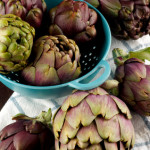One easy tip for making sure fresh fruit and vegetables don’t go to waste is to wash, dry and prep them immediately so they are ready for snacking and cooking right from the fridge.
“Work With What You Got!”
©Tiny New York Kitchen © 2020 All Rights Reserved
Because leeks grow deep in the soil the fine layers inside can be difficult to clean. When using leeks in a recipe, trim and slice the leeks first, then add to a bowl of water and stir. The dirt will sink to the bottom of the bowl.
“Work With What You Got!”
©Tiny New York Kitchen © 2020 All Rights Reserved
These freezer essentials will help you with your weekly meal prep as well as last minute meals that you need to get on the table fast.
Bagged frozen vegetables, like mixed peppers, broccoli, and spinach.
Bagged frozen fruit, like blueberries, mangos, bananas, and strawberries.
Bagged frozen pastas, like tortellini and ravioli.
Frozen waffles and pancakes.
Frozen potatoes, like tots, fries, and breakfast potatoes.
Rice and prepared side dishes.
Pre-made dough, pie crusts, and breads.
Frozen foods are not limited to frozen dinners. You can stock your freezer with healthier ingredients to make putting dinner together easy. There are endless possibilities with what you can make with frozen ingredients. As always, be creative and “work with what you got!”
“Work With What You Got!”
©Tiny New York Kitchen © 2020 All Rights Reserved
Start small, with goals that work for you and your family. These are the habits you’ll keep in the long run.
1. Add More Color To Your Plate
More color on your plate means more variety, more nutrients, and more flavor. The next time you shop, try putting the rainbow in your cart: orange citrus, yellow pineapple, and dark leafy greens.
2. Eat Seasonally
Keep a produce calendar handy so you know what to look for. In season produce is fresher and typically less expensive. January is good for root vegetables, kale, and citrus.
3. Drink More Water
Stay hydrated by infusing your water with citrus slices, herbs, berries, or cucumber. Making water more interesting will encourage you to drink more.
4. Try A Whole Grain Swap For Pasta And Bread
Once in a while replace regular pasta and bread with a whole grain alternative. These complex carbs will help you feel full. Look for whole wheat, whole grain, and multigrain alternatives.
5. Pack Your Snacks
Opt for high fiber and protein snacks like hummus and pretzels or apples and peanut butter. Unlike sugar and empty carbs, fiber ad protein will keep you full.
6. Eat Breakfast More Often
Stock up on on-the-go options. Egg muffins in the freezer, instant oatmeal in the pantry, and a bowl of fruit on the counter. The morning rush won’t be an excuse for skipping this important meal.
7. Make A Shopping List
Check your refrigerator, freezer, and pantry before making a list. Organize your list based on the layout of your store. You’ll save time at the store and won’t accidently buy what you already have.
8. Try A Plant-Based Swap For Meat
Try a meatless version of a weeknight staple like burgers, pizza, or pasta. You’ll get more nutrients into your meals by swapping meat for plant-based options.
9. Stock Your Freezer
Keep staples like frozen meatballs or chicken tenders and steam-in-bag vegetables for last minute meals. A fully stocked freezer is better than takeout. You’ll save money and get dinner on the table even on busy weeknights.
10. Reduce Your Food Waste
Use overripe fruit in smoothies and muffins. Turn leftover vegetables into stir fries and soups. Turning leftover produce into nutrient-dense meals is a win-win for your wallet and your health.
11. Make A Meal Plan
Write meals on the calendar at the start of the week. Everyone knows the menu and you won’t be scrambling for dinner ideas at 5pm.
12. Bring Your Lunch 3 Days Per Week
Instead of swearing off midday takeout, start with 3 days a week. When you pack school lunches, pack office lunches too. You’ll save time waiting in line, save money, and eat better.
13. Try A New Recipe
Shake up your dinner routine with a recipe or ingredient you haven’t use before. You’ll avoid a recipe rut and learn new kitchen skills.
14. Eat Out One Less Time Each Week
Try a speedy dinner or slow cooker meal that’s ready when you get home. Home cooked meals allow you to control the ingredients and choose more healthful options.
15. Drink Less Soda
Swap for flavored seltzer, iced tea, or sparkling fruit juice. Instead of cutting out soda try drinking 1 less can a day. Quitting cold turkey makes habits hard to break. Start with a smaller goal and eventually it will make a big difference.
16. Eat Together One More Night Each Week
Make dinner device-free, with everyone eating together. Keep it fun with a top-your-own taco, baked potato, or burger night. Enjoying a meal together as a family has been shown to encourage healthy eating habits and better communication.
17. Cook With Your Children Once A Week
Children who help choose, shop for, and prepare a recipe will be more interested in eating it.
18. Get Ahead On Sunday
Prep components instead of entire meals. Roast vegetables, cook grains, and bake extra chicken, then mix and match for quick lunches and dinners during the week. Planning ahead helps you save time, eat better, and reduce the stress of busy weeks.
19. Embrace Healthy Fats
Look for sources of unsaturated fats, like olive oil, nuts, seeds, and avocados. Good-for-you fats help regulate cholesterol, absorb vitamins, and prevent heart disease.
20. Give Plants More Plate Real Estate
Fill about half of your dinner plate with plants, then divide the rest between your starch and protein. Rebalancing your plate is an easy way to eat healthfully.
“Work With What You Got!”
©Tiny New York Kitchen © 2019 All Rights Reserved
Kohlrabi (pronounced cole-rah-bee) is in season now. This funny looking vegetable is so versatile and delicious. Try it raw in a crunchy slaw, blended into a velvety soup, or in place of rice for a low-carb side.
Though it looks like a root, kohlrabi is actually a bulb that grows above ground. It’s in the same family as cabbage, kale, Brussels sprouts, and cauliflower.
When eaten raw, kohlrabi is crunchy and mildly peppery, like radishes. When cooked, it becomes slightly tender and sweeter (similar to turnips and parsnips). The skin, while colorful, is slightly tough and won’t soften when cooked. Go ahead and peel first.
You’ll find both green and purple varieties though they taste the same. Look for firm, solid bulbs. Refrigerate unpeeled bulbs in your crisper drawer for about 2 weeks.
If leaves are attached, remove and reserve for other recipes. Cook them as you would kale. Cut a thin slice off the bottom so the bulb sits flat. Peel off the tough outer skin with a vegetable peeler. Slice into quarters, lengthwise, then cut out the core from each piece. Dice, slice, or shave per recipe instructions. Roast kohlrabi to bring out its naturally sweet and nutty flavor.
Only 37 calories per 1 cup of raw diced kohlrabi. 472 mg potassium per cup of diced kohlrabi, or as much as a medium banana. Potassium is essential for keeping your heart and nervous system working in top condition.
“Work With What You Got!”
©Tiny New York Kitchen © 2020 All Rights Reserved
Healthy snacks give your family the energy and nutrients they need throughout the day. As you plan snacks, think of them as “mini meals” that include two of the four food groups.
Try these simple nutritious snack ideas:
1. Whole grain crackers with a cheese stick
2. Fresh cut fruit with a yogurt dip
3. Nut-free trail mix. Mix dried cranberries, raisins, dried apricots, and apple rings with sunflower and pumpkin seeds, along with your family’s favorite cold cereal.
4. A small tortilla wrap spread with Greek yogurt, some jam and a banana.
5. A smoothie made with vanilla yogurt, blueberries, apples and some orange juice.
6. Vegetable sticks (like cucumbers and carrots) dipped in hummus.
Make snacks interesting by using a variety of shapes, colors, and textures.
• Offer different types of cheese (mozzarella, cheddar, Jack, Swiss) in different forms (cubes, strings, slices, and balls)
• Switch up the vegetables and fruit. Make sure you have a colorful variety in the fridge to choose from.
• Kids love to dip. Use cottage cheese, hummus, yogurt, or guacamole as healthy dips.
From planning to packing, get everyone in the family involved when making snacks. Take children grocery shopping and let them choose some of their favorite foods like breads, vegetables, fruit, and yogurts. Set aside time in the evening to pack lunches and snacks. You’ll be happy you did during the next day’s busy morning rush!
Food Allergies: Schools have different policies when it comes to food allergies. Many schools have a nut-free policy throughout the whole school, and some have policies just for some classrooms. Find out about the food allergy policy at your child’s school. Once you know about the foods that need to be avoided, keep them in mind when reading the ingredient list on food labels and when packing lunches.
Back to school snacks can be nutritious and delicious. With a little planning and creativity, your kids will love snack time at school.
“Work With What You Got!”
©Tiny New York Kitchen © 2019 All Rights Reserved
Fire things up with popular hot sauces. Whether you’re just starting to heat things up or you’re looking for new options there’s a sauce to spice up any meal.
HARISSA
This thick North African sauce combines hot peppers with garlic and other seasonings. It’s traditionally served with couscous, but harissa can also add flavor and fire to everything from meat and fish to vegetables and eggs.
SRIRACHA
While there is sriracha from Thailand (it’s named after the town where it was created in the 1930s), the wildly popular one used in everything from wings to Bloody Marys is produced in Southern California. Both feature fresh red chilies, sugar, salt, garlic, and vinegar.
GREEN HOT SAUCE
Most hot sauces are red because they’re made with red peppers, but there are green versions, which are typically made with jalapeños and/or poblanos and sometimes tomatillos. Green sauces can be milder or more herbal, but heat levels vary from sauce to sauce.
LOUISIANA STYLE
Most hot sauces are based on the Louisiana style formula of chilies, vinegar, and salt, and puréed into a thin red liquid. Which peppers are used, how they’re processed, and additional ingredients make for endless variety.
MEXICAN HOT SAUCE
South-of-the-border sauces tend to use the same Louisiana style combination of chilies, vinegar, and salt, and have a similar flavor, but if you’re eating tacos, why not reach for a bottle from Mexico? Many include chipotles, which are dried and smoked jalapeños, and add smoky flavor.
“Work With What You Got!”
©Tiny New York Kitchen © 2019 All Rights Reserved
If vegetables could speak, asparagus would surely say “spring.” While it’s available all year, nothing compares to the fresh spears that appear each spring. Asparagus is one of the first crops of the season, and after a long winter, when green produce is sparse, seeing the tips peek out of the soil is a welcome sight. A short shelf life means it’s best to seek out local asparagus. Look for glossy spears, tightly closed tips, and freshly cut ends.
While green is the most common asparagus, you can often find purple and white spears in stores.
Purple asparagus is grown the same way as green and is also green on the inside. These spears usually taste a bit sweeter and nuttier and are tasty raw.
White asparagus is grown without sunlight, so it doesn’t produce chlorophyll, which keeps it colorless, or white. The stalks should be peeled before cooking. It’s milder in flavor and less grassy than green and best served blanched.
“Work With What You Got!”
©Tiny New York Kitchen © 2019 All Rights Reserved
An ancient symbol of fertility, artichokes are fitting for spring, when we celebrate renewal. Find them year-round – fresh, frozen, canned, and jarred. Artichokes are at their best from March to June.
To Trim Artichokes
Pick off the tough outer leaves until you reach paler, more tender leaves.
With a chef’s knife, cut off the top one-third of the artichoke and all but an inch of the stem.
With a paring knife, cut off the tough green skin on the stem and any tough leaves near the base.
Cut the artichoke in half lengthwise.
With a melon baller or small spoon, scoop out and discard the “choke,” the spiky interior near the stem.
While trimming, keep artichokes in a bowl of water with lots of lemon juice so they don’t turn brown.
“Work With What You Got!”
©Tiny New York Kitchen © 2019 All Rights Reserved
If you want to lower your risk of heart disease and lose weight, without feeling deprived, the Mediterranean diet just might be the plan for you. The Mediterranean diet is known for being one of the healthiest eating patterns and one of the easiest plans to follow. In fact, research has shown that it can lower bad cholesterol, lower risk for certain types of cancer, and even improve brain health. The Mediterranean diet doesn’t call for eliminating entire food groups, but encourages smart choices from each.
GRAINS
Many of the grains you will find available in the Mediterranean diet, like barley and buckwheat, are whole grains, which have so many health benefits. Whole grains are not only packed with heart-healthy vitamins and antioxidants, they also contain fiber. Fiber is good for digestive health and heart health, as it can help lower LDL cholesterol (the type of cholesterol that causes heart disease). The Mediterranean diet also encourages enjoying whole-grain breads with olive oil instead of butter because of the heart-health benefits.
FRUITS & VEGETABLES
The diet places an emphasis on consuming plenty of fruits and vegetables. Cucumbers, tomatoes, kale, onions, bell peppers, broccoli, and spinach are all great examples. Combining vegetables with whole grains, in a pasta salad or couscous for example, is a great way to enjoy both. Fruits such as berries, apples, melons, and figs all make great snack or even dessert options. For breakfast you can easily combine fruits with whole grains for a breakfast muesli or try blueberry pancakes made with buckwheat.
PROTEIN
Protein from lean sources such as poultry and seafood are encouraged at least twice a week. However, red meat is supposed to be limited to only a few times per month. Seafood is encouraged because of the heart healthy fats, which are good for brain and heart health. Lean poultry is encouraged because it’s low in saturated fat, but high in protein, which is good for muscle building and satiety. Lemon chicken salad or Tuscan chicken stew would both be great dishes to include on the plan.
DAIRY
Dairy is allowed on the Mediterranean diet, but moderation is key. Instead of fat-free or sugar-free yogurt, switch to plain Greek yogurt, which is lower in sugar, but higher in protein. Low-fat milk and cheeses like feta and brie are also allowed, but moderation is encouraged because of their saturated fat and sodium content. For a simple and healthy weeknight dinner, try combining grilled chicken kabobs with a lemon-dill Greek yogurt dipping sauce.
NUTS & LEGUMES
Nuts, seeds, and legumes are encouraged because they contain heart-healthy fats and fiber. Almonds, walnuts, cashews, peanuts, and sesame seeds can be enjoyed as a snack or sprinkled on vegetables or hot cereals. Legumes, such as split peas and red lentils, are great in soups, stews or on top of salads. Try making hummus at home by using chickpeas, olive oil, and lemon juice, then enjoy it with grilled chicken, sliced bell peppers, and whole-wheat pita bread.
HEART-HEALTHY FATS
Saturated fats like butter are discouraged on the Mediterranean diet, which instead urges heart-healthy fats from olive oil, nuts, seeds, and avocados. Heart-healthy fats can actually help raise HDL cholesterol, which is the good cholesterol that our bodies make in order to fight heart disease. To incorporate them, opt for a baked potato with a drizzle of olive oil, or try adding diced avocado to green salads with grilled chicken. If creamy chicken salad is more your pace, serve it with chopped olives.
SEASONINGS
Instead of using salt to season your dishes, the use of herbs and spices is highly encouraged on the Mediterranean diet. Garlic, rosemary, thyme, sage, mint, and basil are all great flavors to add to simply grilled chicken or green salads. Citrus juice from lemons, limes, and oranges can also add flavor that’s perfect for salads and marinades. Try experimenting at home with different seasonings, and find what works for you.
VARIETY & BALANCE
The Mediterranean diet has a lot to offer in terms of variety and health benefits. In additions to focusing on making smart choices, the plan also encourages family meals and making time for physical activity. Lean protein, whole grains, fruits, vegetables, and low-fat dairy are all smart choices that can help you maintain a Mediterranean-style eating pattern. One you and your family can stick to.
“Work With What You Got!”
©Tiny New York Kitchen © 2019 All Rights Reserved















